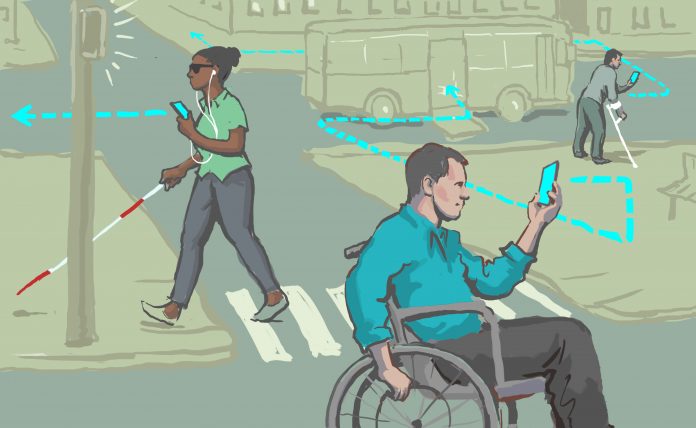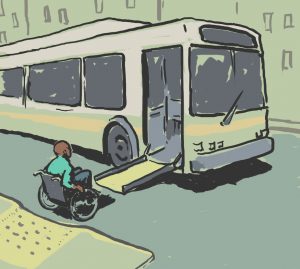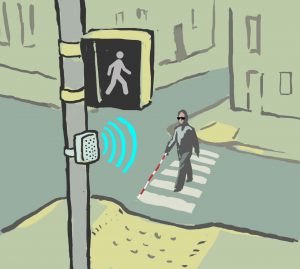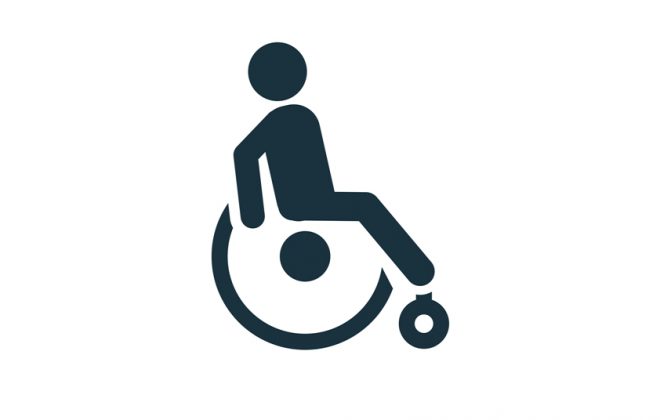Smart cities work for people with disabilities
By Emily Louise Bowman – Aug 3, 2017

Smart cities, so named because they boast technology and design that make them work better for their residents, are getting a lot of attention — and government funding — in the U.S.

Some smart city elements are easily spotted: a bike-share network or crosswalk signals that count down the seconds before the light changes. Others are less obvious, but also help cities run efficiently, like traffic control systems that adapt to traffic patterns. Crowdsourcing, or more specifically the data it yields, helps city governments better understand citizen habits and needs.
(State Dept./Doug Thompson)
While smart cities have existed in theory since the 1980s, their presence expanded in the past decade along with the rapid integration of technology into everyday life. By 2025, demand for smart city services is expected to grow by more than 30 percent across Europe, Africa and Latin America.
Helping people with disabilities
James Thurston of G3ict and Victor Piñeda of World Enabled tell a story of a South African man who used an app created by his city’s government to help people access public transportation. He tracked a wheelchair-accessible bus and rolled up to his stop just as the bus arrived. But he had to sit and watch it pull away because the app didn’t mention he would have to descend steps to access the bus stop.
Stories like this are why Thurston and Piñeda created Smart Cities for All, an initiative to guide city halls and private industry partners toward inclusive thinking in urban planning.
As cities worldwide invest in technology, urban life could become more inclusive for people with disabilities.
Accessible is smart

The Smart Cities for All Toolkit aims to fix the disparity in cities through smart technology, making cities both smart and accessible to a range of users regardless of their abilities or disabilities.
(State Dept./Doug Thompson)
Accessible cities use assistive technology and integrate accessibility into city design, infrastructure and services. Rather than being a novelty, accessibility is becoming a hallmark of good smart city design.
When the U.S. Department of Transportation held its Smart City Challenge in 2016, one of the application requirements was to increase inclusivity, including for people with disabilities.
Kansas City, Missouri, is one finalist that has launched new accessible smart services.
“I’m just really proud of our kiosks,” says Meg Conger, the city official charged with ensuring the city complies with the Americans with Disabilities Act. In the past six months, Kansas City has launched a network of interactive digital kiosks that can collect and share information. “Because they are accessible, no matter your ability level, you get the same information.”
While the initial kiosk design had touch screens and text-talk capabilities, Conger wanted to go further. Understanding the everyday obstacles for people in wheelchairs and those with limited movement, she asked that kiosks be set lower and be equipped with easy-to-see, backlit touch screens. The information on the screens scrolls, rolling from top to bottom, giving people an opportunity to use it at whatever height-level is best for them.
“I don’t know if every city would think of that — that just because you can touch doesn’t mean you have lots of movement,” Conger says. The kiosks have an audio jack so that visually impaired users won’t feel self-conscious about listening to information available in the text-to-voice feature. They simply plug in their own headphones and listen privately.
Kansas City joins a growing global trend: A trans-Atlantic organization called the PICASSO Project hosts an annual conference on international collaboration on smart city technology and policy. Through smart-city partnerships like this, tech solutions may spread worldwide, making urban centers more accessible to everyone.
Content retrieved from: https://share.america.gov/smart-cities-work-for-people-with-disabilities/.
Upcoming Events
There are no upcoming events.



